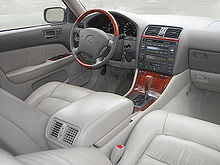Lexus UCF20
| Lexus | |
|---|---|
|
Lexus LS 400 (1994-1997)
|
|
| LS | |
| Production period: | 1994-2000 |
| Class : | Upper class |
| Body versions : | limousine |
| Engines: |
Petrol engines : 4.0 liters (194–216 kW) |
| Length: | 4996 mm |
| Width: | 1829 mm |
| Height: | 1420-1435 mm |
| Wheelbase : | 2850 mm |
| Empty weight : | 1659-1764 kg |
| Previous model | Lexus UCF10 |
| successor | Lexus UCF30 |
The Lexus UCF20 , sales name Lexus LS400 (Toyota Celsior in Japan), is the second generation of the luxury class car Lexus LS from the Lexus brand belonging to the Japanese automobile group Toyota .
history
Like its predecessor, the car was offered in the USA and Europe as the LS400 - in Japan as the Toyota Celsior . The UCF20 had the four liter big V8 of its predecessor with a slightly to 194 kW (264 PS / 260 bhp = English horsepower) increased power. In addition, the car was 95 kg lighter than its predecessor and therefore both more economical and slightly better in acceleration. The drag coefficient ( ) has been reduced slightly from 0.29 to 0.28. Among the facilities included, among other things, one of the first slot-in - CD changer .
In mid-1995 the car was briefly affected by US tariffs on Japanese luxury vehicles, which drove the sales price from around US $ 51,000 to over US $ 100,000. Nevertheless, 1995 was the best sales year for the second generation, while the model sold significantly worse than both its predecessor and its successor . Total production was around 114,000 vehicles.
In Germany, the car was offered from the spring of 1995 at a base price of 116,400 DM.
Special features on the engine
Toyota 1UZ-FE
The 4.0 L aluminum block 1UZ-FE debuted in 1989 in the first generation of the Lexus LS 400 / Toyota Celsior and was then gradually installed in other Lexus and Toyota models. It is a short-stroke internal combustion engine (oversquare engine) with a piston diameter of 87.5 mm (3.44 in) and a stroke of 82.5 mm (3.25 in).
Special features are:
- Low vibration
- The crankshaft main bearings are each fastened with six bolts
- The camshafts and water pump are driven by toothed belts
- Pistons are made of a special alloy ( hypereutectic piston)
The similarity of the 1UZ engine to racing engines (6-bolt main bearing / short stroke ratio / special piston configuration) was confirmed in an interview (with v-eight.com) in 2007 by David Currier, Vice President of TRD-Toyota Racing USA. The 1UZ platform is based on IndyCar / Champ Car engines. It was planned to be used in GT500 racing cars - but it was used in the Daytona prototype.
The 1UZ-FE has a compression ratio of 10: 1 and an engine output of 191 kW (256 hp) with a torque of 353 Nm.
In 1995 the engine was redesigned by installing lighter connecting rods and pistons and increasing the compression ratio to 10.4: 1 - the result is 194 kW (264 hp) and 363 Nm.
In 1997 Toyota introduced variable camshaft adjustment (VVT-i) and again increased the compression ratio to 10.5: 1, which improved power and torque (216 kW / 290 PS and 407 Nm). In the Lexus GS400 it is 300 PS and 420 Nm.
Ward's AutoWorld magazine selected the 1UZ-FE as one of the ten best engines in the world from 1998 to 2000.
The engine was installed in:
- Lexus LS 400 / Toyota Celsior (1989-2000)
- Toyota Crown / Toyota Crown Majesta (1990-2002)
- Lexus SC 400 / Toyota Soarer (1991-2000)
- Lexus GS 400 / Toyota Aristo (1992-2000)
- Toyota MR2 Le Mans Car
Facelift
With the Lexus UCF21 , the revised model of the LS appeared in September 1997.
The innovations were xenon light , variable camshaft control , 5-speed automatic transmission, slightly revised chassis and steering, revised front design and mirrors and wheels, rear window antenna , vehicle dynamics control , side airbags and brake assist . The headlights are equipped with an additional function with which you can individually program the setting of the ambient lighting. Optionally, a stand CD-ROM -based GPS - navigation system available.
In February 2000 Lexus brought out the limited "Platinum Series".
Sold in Japan Toyota Celsior has an adaptive cruise control on lidar introduced basis.
Web links
Individual evidence
- ↑ Electronics Parts . Toyota. 2012. Retrieved January 18, 2015.





